
Electronic english version since 2022 |
The newspaper was founded in November 1957
| |
Historical cross-section
A decade of the Institute: results, considerations, plans
Our task is to preserve historical details.
V.A.Nikitin
Institute Dubna - 1966
In the early days of JINR foundation, when the issue of establishing the Laboratory of Theoretical Physics was still under discussion, some authoritative people spoke against the separation of theorists into an independent laboratory, such as, the future academician M.A.Markov, although he was a theorist and a close friend of D.I.Blokhintsev. V.I.Veksler was definitely against it, fearing that the theorists would go into the maze of some theory of quantized fields and stop working on the experiment. And when Academician N.N.Bogolyubov was nominated for the position of LTP Director, these fears only increased. But 10 years have passed and nothing terrible has happened: we see that the LTP theorists keep their hand on the pulse of physical experiment. At the beginning of the year, a paper by graduate student Leonard Malov and his supervisor V.G.Soloviev, co-authored with S.M.Polikanov was published that offered a qualitative explanation of spontaneously fissile isomers, the first of which, the americium-242 isomer was discovered by Polikanov in late 1961, during the first attempt to synthesize element 104.
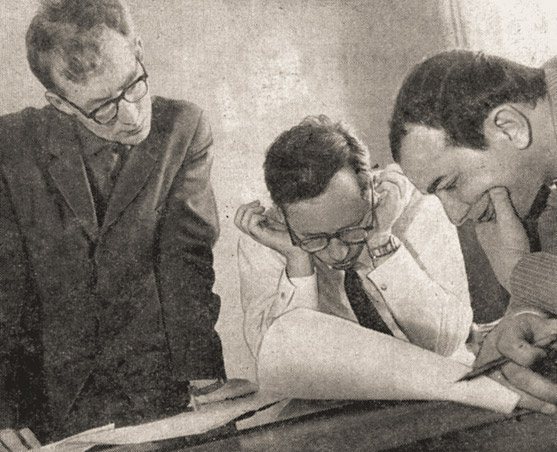
Leonard Malov, Vadim Soloviov, Ilia Khristov. "There's a lot to think about..."
Almost simultaneously, a fundamental paper by Moscow theorist Vilen Strutinsky outlining a new theory of nuclear fission was published. Spontaneous fission of nuclei from the isomeric state obtained an exhaustive explanation in it. But the most intriguing for LNR physicists was the prediction of a new "magic" nucleus and a probable "island of stability" in the range of element 114. (By the way, in the same year, a paper by Boris Kalinkin, Adam Sobichevsky and MSU graduate student Fangil Gareev with the same prediction was published).
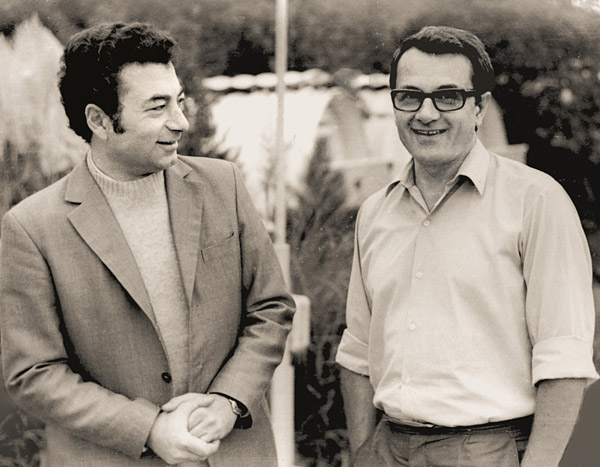
Yuri Oganessian and Vilen Strutinsky
Thus, the ban on superheavy elements was lifted and the LNR physicists (primarily, G.N.Flerov, although he did not trust the theorists and had reason to do so) breathed a sigh of relief. But at the same time, they were busy with the tasks of "short-range sighting" in LNR. Another achievement of the laboratory: a year and a half of work, 16 experiments and the chemical identification of element 104 was completed. The author of the original technique that allowed us to establish the chemical "kinship" of atoms with hafnium using several dozens of them that live for a fraction of a second is a young Czech chemist Ivo Zvara, a graduate of the Moscow State University Chemistry Department.
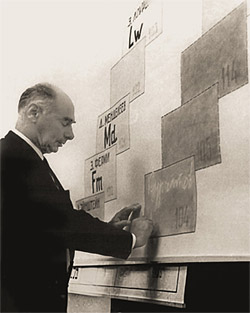 |
| Georgy Flerov is adding the chemical element Ku to the Mendeleev table |
LNP Director V.P.Dzhelepov reports on the laboratory's successes. Over several years, the intensity of the first Dubna accelerator has been increased dozens of times. It is one of the best in its class. And there are plans to increase the intensity even more. This is the tit in the hand and the crane in the sky - the meson factory, a new accelerator with a beam intensity 1000 times greater than that of the synchrocyclotron. The idea dates back to 1955 when the director of the oldest laboratory in Dubna was M.G.Meshcheryakov. And already in 1959, he and V.P.Dmitrievsky reported. P.Dmitrievsky reported on the operating prototype of this accelerator at the 2nd International Conference on Accelerators in Geneva. The Chinese sharply opposed it. It all comes down to money. The project is very expensive. It can eat up the JINR budget for the whole five-year period. Today, the Chinese are gone but so is the money...
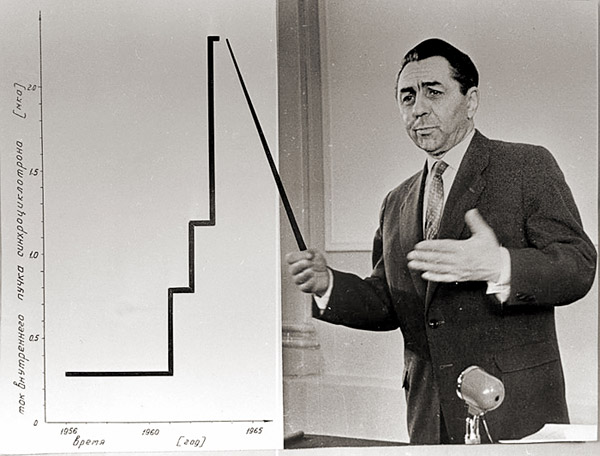
LNP director Venedikt Dzhelepov
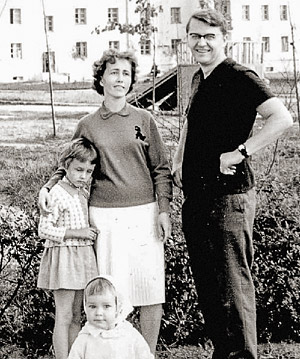 |
| Ivo Zvara with his wife and daughters |
Another acute problem that is also related to LHE is the growing lag behind Europe and the United States in the speed of processing experimental data - images from bubble chambers, the so-called movie data. As a physicist that had an opportunity to compare said while in Dubna a point is processed, in CERN it is possible to process a whole curve. And JINR Scientific Council made a fateful decision. The prologue to this decision was a letter from Yury Karzhavin sent to JINR Directorate: it proposed to establish a special laboratory. Yury Karzhavin wrote everything in it, down to the positions and names, leaving only the column "Laboratory Director" empty.
It was filled by Academician N.N.Bogolyubov. He offered Corresponding Member of the Academy of Sciences M.G.Meshcheryakov (MG remembered this date firmly: the telephone conversation took place on 12 April, 1966) to establish and to head the new laboratory. In Dubna, they still remembered that at one time, headed by this disgraced member of the Academy of Sciences, the largest accelerator in the world was developed in a record two and a half years that laid the foundation for high energy physics in the USSR. The laboratory was tasked with eliminating the catastrophic lag behind the world's nuclear centres in the processing of experimental data within a historically short period of time.
In summer, a meeting of experts was held and on 19 August, JINR Director signed an order and this date became the birthday of LHTA. A few days later, Yury Karzhavin and mathematician Vladlen Shigaev that had collaborated with him since 1965, left for CERN to study the HPD scanning system (named after its inventors: Hough-Powell device) in operation.
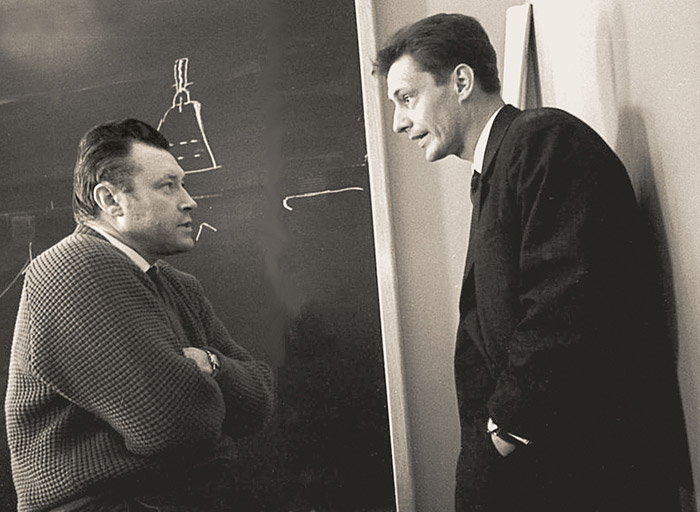
Yury Karzhavin (right)
Karzhavin could have become deputy director of LHTA but another strong personality (as V.N.Shigaev put it) got in his way - G.I.Zabiyakin from LNP. Both of them were tall and stout, both of them were given the advantage by nature to look down on others from above (only V.P.Dmitrievsky seemed to be able to talk to them on equal terms without cocking his head upwards) but Georgy Ivanovich was also "a little bit sweatier" - he became a deputy and he signed official documents as "First Deputy Director of LHTA", although there was no such position in the staff schedule (and here again, we refer to V.N.Shigaev). Karzhavin, on the other hand, headed the Automation Department.
Nikolay Govorun, Head of the Mathematics Department of the Higher Centre, took over the mathematical processing of the experimental data and without wasting time got down to business. The strategy was as follows: to make a Fortran translator on the newest Soviet computer BESM-6 that JINR was going to buy and to adapt the ready-made library of CERN data processing programmes. Three people responded to the call to write a translator: Igor Silin (the author of the famous FUMILI programme and autocode on M-20) and Vladislav Shirikov and Vitaly Zaginaiko, both already skilled in programming. And then, as Vladislav Pavlovich recalled, "they started to recruit anyone". The company gathered a decent number of people. The future author of a monograph on BESM-6 programming and a graduate of the Moscow State University's Faculty of Mechanics Gennady Mazny was among those that got into it. When he asked which of the proposed topics he could apply his knowledge of higher algebra to, Govorun advised: choose Fortran, there are letters there too!
The LHTA was founded on the basis of the Computing Centre and it was taken for granted that the "second" deputy director would be the head of the Computing Centre E.P.Zhidkov. But Govorun was appointed. An initiative group of Vetseshniki went to Bogolyubov to lobby for Evgeny Petrovich. They took Govorun with them and persuaded him to go, although he knew exactly how it would end. And so, it ended. Bogolyubov not accidentally put Govorun, his candidacy was recommended to him by Academician A.N.Tikhonov and Corresponding Member A.A.Samarsky... The walkers returned discouraged, confused, embarrassed and even a little frightened - God forbid to experience the wrath of high superiors! As recalled 20 years later, shivering, the initiator of the trip to Bogolyubov, Nikolay Nikolaevich even stomped his feet... But three years later, the FORTRAN-DUBNA translator started operating, physicists started writing programmes in Fortran, a rich library of data processing programmes in this language came from CERN and Dubna became one of the leading centres of system programming in the USSR and then everyone was relieved to decide that it was for the best.
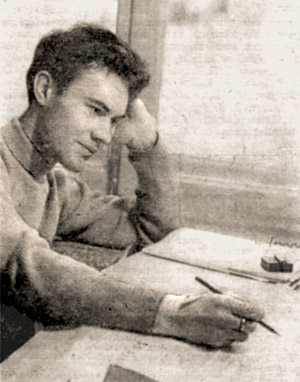 |
| Photographer Yury Tumanov caught shift supervisor Vladimir Ananiev studying automatic control schemes of a new physical device |
The next day, the young man, accompanied by Ilya Mikhailovich, goes to the "look". Dmitry Ivanovich gives the "go-ahead". He is a worthy candidate. He is to be the chief engineer of the project. The young man confesses that he is not quite sure of his abilities and he hears in reply: "How old are you? Thirty? At your age, people were running ministries!" That's how Vladimir Dmitrievich recalled it many years later.... IBR-2 really became the main business of his life. His colleagues jokingly compared him to Prometheus that voluntarily chained himself to IBR-2. He said it himself and there was pride in his voice. Really, there's a lot to be proud of....
What else was memorable about that year? The Dubna Institute followed the whole country in adopting a five-hour work week. A meeting of the General Assembly of the International Mathematical Union was held in Dubna that was attended by prominent mathematicians of the world, including Academician A.N.Kolmogorov. JINR Director Academician N.N.Bogolyubov was elected to the Supreme Soviet of the USSR. The phenomenon of the so-called deep inelastic transfer of nucleons in nuclear reactions that allowed a new look at the production of the compound nucleus in the synthesis of superheavy elements was discovered by V.В.Volkov's group in the Laboratory of Nuclear Reactions. In September, Veksler died and Park Street was named after him, the last of the three Park Streets to retain this name. And for Leonid Golovanov, inventor and enthusiast of diving, future Honorable Designer of the Russian Federation, that year was remembered by the fact that he sailed alone from the Bolshaya Volga pier to the JINR recreation centre on Lipnya Island. The only audience and fans were fish, seagulls and fishermen in boats that offered: "Can I give you a ride?"
Well, now, as Viktor Ivanovich Balashov, the announcer of central television said, pushing aside the official texts that were read out word for word.... No, not about the weather. About the builders. Fears that after the Chinese had left JINR there would be layoffs did not come true but the volume of housing construction was greatly reduced and it hit the builders. They appealed to the Ministry of Shipbuilding Industry, proposing to build in Dubna a pilot plant of the Acoustic Institute that was scheduled to be constructed in Konakovo. And the Ministry grabbed this proposal. This is how the town-forming enterprise "Atoll" appeared on the Bolshaya Volga a few years later.
On the whole, it was a very prosperous year for the Institute, as well as for the USSR. Leonid Brezhnev became General Secretary of the CPSU Central Committee whose authority was characterized by calmness, the economy was booming and focus was on the social sphere. There were new stores - department stores, garden plots were distributed, free circles for children opened. In Dubna, the construction of the first swimming pool "Archimedes" began and in the area of Alushta - the Resort Hotel for JINR employees.
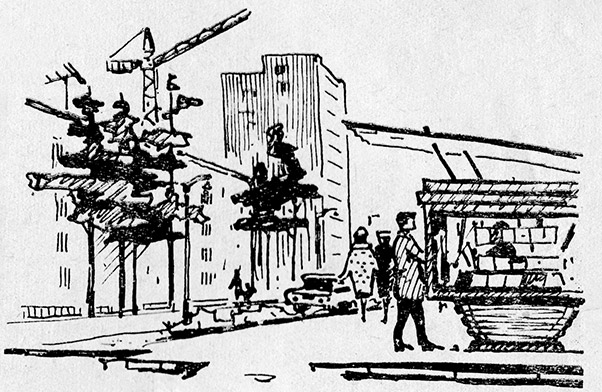
Dubna is getting better. Drawing by artist Yury Sosin. The first "skyscraper" of the city - a 10-storey building on Leningradskaya Street. Brigade of bricklayers of Valentin Kabanov, having turned to self-financing, saved more than 6 thousand bricks and 19 cubic meters of concrete during construction
Alexander RASTORGUEV